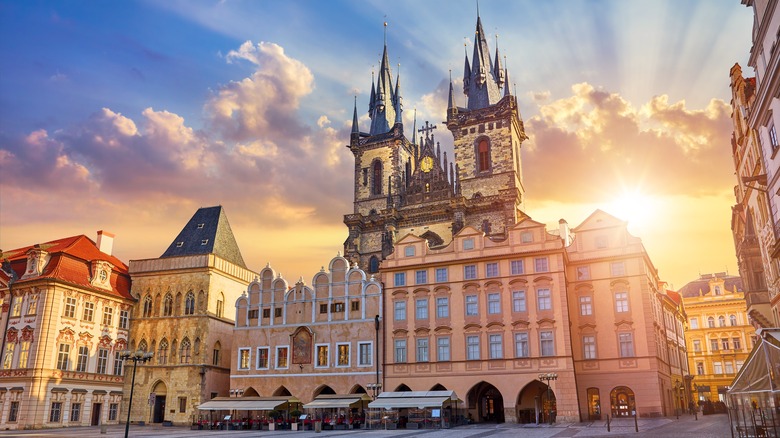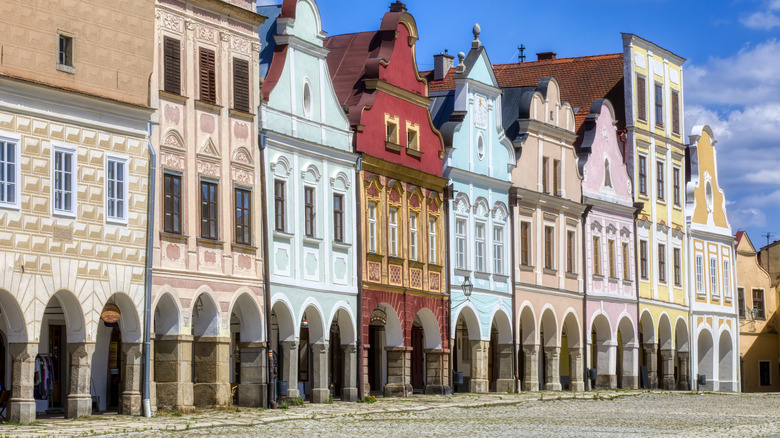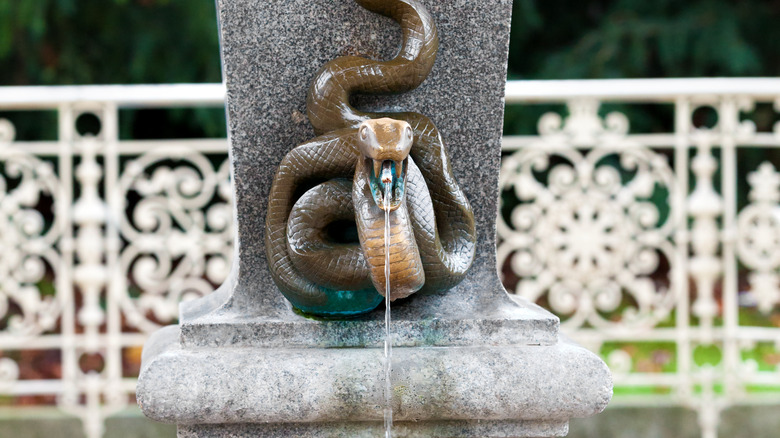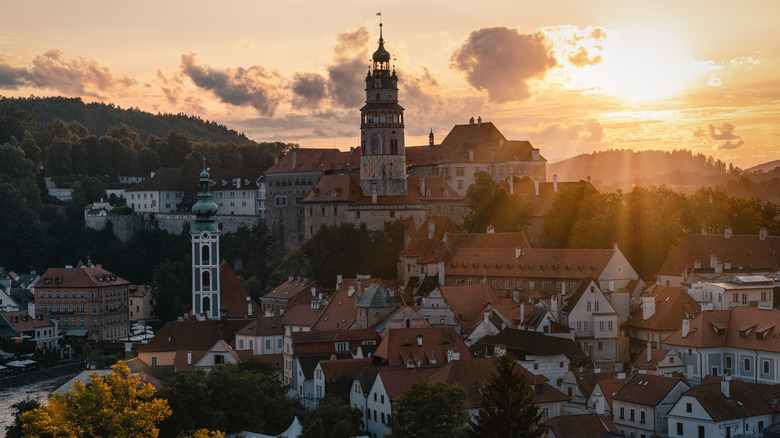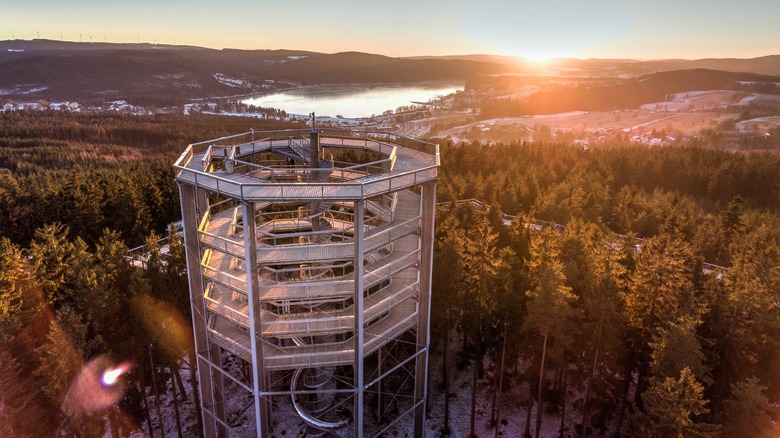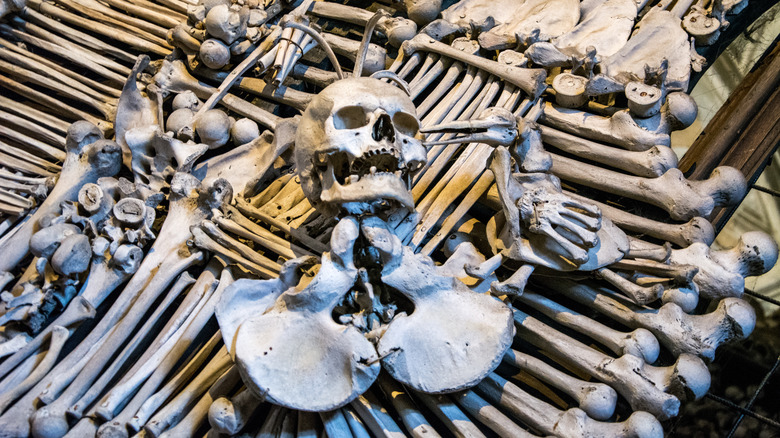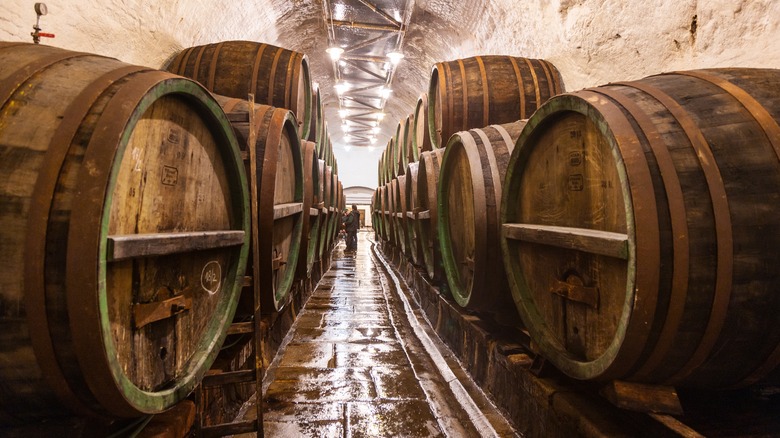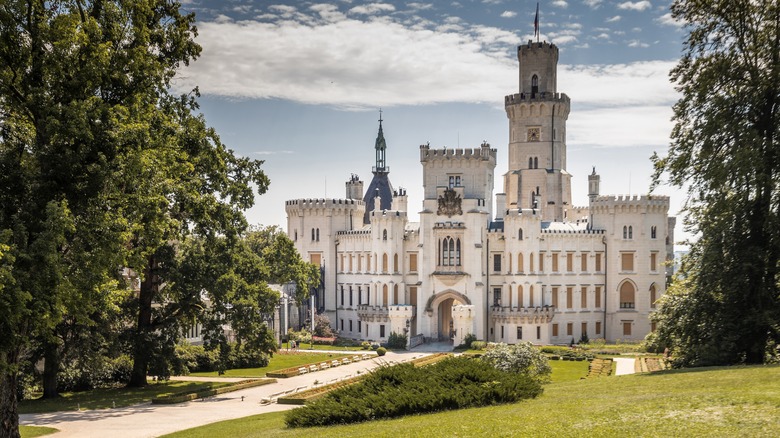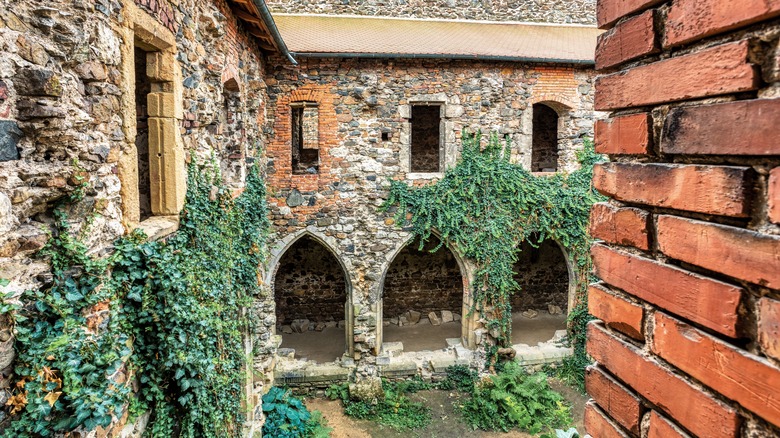The Czech Republic's Top 14 Iconic Tourist Hot Spots You Can't Miss
Slotted between Poland, Slovakia, Austria, and Germany is the lovely — and truly underrated — country of Czechia, or the Czech Republic. One of Europe's safest countries, the destination is also home to dazzling cities, fairytale castles, and friendly locals. And although its capital, postcard-worthy Prague, is pretty well-known, the rest of the country is often overlooked — which is too bad, as it too is beautiful, scenic, historic, charming, and fun.
Using personal experiences traveling within Czechia, as well as data from local tourism boards and travel experts (both local and international), we've compiled a list of 14 of the best sights in this hidden gem of central Europe. Covering from UNESCO World Heritage sites to national parks, historic breweries, restored castles, wine countries, war memorials, and so much more, you'll quickly see why it's worth venturing out beyond Prague to explore a lot more of this amazing country.
Prague Castle and Lesser Quarter (Malá Strana)
Prague Castle is the star of Prague's skyline. One of the most awe-inspiring castles in Europe, the UNESCO World Heritage Site dates back to around 880. Considered the largest ancient castle in the world, Prague Castle feels like its own little city — with cobbled streets, quaint buildings, and some of the country's most important treasures. The gorgeous, Gothic St. Vitus Cathedral, for example, can be seen all over the city, and the charming Golden Lane is lined with colorful houses from the 15th century. Admission to castle's main circuit starts from around $21 per person.
Directly below Prague Castle is Malá Strana, or the Lesser Quarter. One of the city's most beautiful neighborhoods, the historic streets lead to the castle and the Charles Bridge. Malá Strana also leads to Petřín Hill, which boasts sweeping panoramic views of Prague. For the best city vistas, take the funicular up to Petřín Tower and walk 10 minutes to the historic Strahov Monastery. Still an active monastery, and dating back to 1140, the grounds are free to explore. Once you've soaked in the peaceful surroundings, make sure to sample the beer and see one of Prague's most enchanting tourist attractions, the fairytale Strahov Library.
Prague's Old Town Square and Charles Bridge
From the Lesser Quarter, another Prague must-see is the iconic Charles Bridge, which dates back to 1402 and connects Malá Strana to the city's Old Town. Pedestrian-only, the Charles Bridge can get very busy, so if you're hoping to avoid the crowds during your trip to Prague, visit early in the morning or night. As you walk across, pay close attention to the two accompanying towers (one on either end) and the various statues lining the bridge.
After crossing, you'll be in Prague's gorgeous Old Town. The highlight here is the Old Town Square, which was originally built in the 10th century. Crowned by the dark peaks of a Gothic cathedral and the former town hall, the area is lined with colorful facades and cafes, and also hosts the Christmas market. Additionally, the Old Town Hall is also home to another one of Prague's most famed attractions: the world's oldest Astronomical Clock. Ticking for well over 600 years, tourists still gather to watch it mark the changing time every hour.
Moravian Wine Country
While the Czech region of Bohemia is all about the beer, the country also makes some truly excellent wine in the region of Moravia. Starting in the small, charming town of Mikulov — a storybook town with vineyards, castles, and endless wine tastings — visitors can enjoy an authentic experience without the crowds.
In addition to Mikulov, Moravia is also where you'll find the UNESCO-listed Lednice-Valtice Cultural Landscape, anchored by the historic Lednice and Valtice palaces. For a unique experience, head to the cellar of Château Valtice to visit the official Wine Salon of the Czech Republic. There, you can sample approximately 100 of the best Czech wines, selected yearly by an expert panel. A two-hour pass enables you to sample as many as you like — just don't forget to help yourself to some of the complimentary bread to soak it all up.
Fall, and the harvest season, is an especially gorgeous time of year to visit the charming towns of Moravia. Additionally, it's also the only time of year you can sample burčák, or "young wine" — a surprisingly strong, sweet wine still in the process of fermenting. September is also when Mikulov hosts the lively Pálava Wine Festival, which draws wine lovers from across the region.
Telč's Historic Center
The beautiful Czech wine country of Moravia is also home to another UNESCO Heritage Site: the Historic Center of Telč. A hidden fairytale town with colorful streets and scenic squares, the destination is renowned for its incredibly well-preserved Renaissance square, which is lined with brightly colored facades. Also referred to as the "Moravian Venice" thanks to its surrounding moats and ponds, Telč (pronounced "Telch") is far enough away from Prague — about two hours by car — to feel relatively undiscovered. Plus, it's also small enough to be explored in a day. If you have the time, however, we recommend spending longer to truly soak it all in.
As you approach Telč's main square, you'll pass through its 14th-century walls before meandering the winding streets to the square — which, in reality, looks more like a triangle. Once there, the artistic buildings are lined along the arcades, with beautiful churches and the Telč Castle standing near the end.
Stop at one of the many cafes, pubs, or boutiques before stepping into the Church of St. Jacob to climb the tower, or venturing into the castle. Additionally, non-claustrophobic visitors will also want to head below to the Telč Underground, a series of ancient tunnels that connect the town with the castle.
Karlovy Vary
Europe's spa towns once attracted the wealthy and royal for their therapeutic waters. Today, 11 of these spa towns — scattered across seven countries — are on the UNESCO Heritage list, classified as "The Great Spa Towns of Europe." And while Europe's spa towns have fallen in and out of favor, Karlovy Vary (or Carlsbad) still retains its glamour and many spa amenities.
Founded by Charles IV in 1358 — who, legend has it, discovered the water during a hunting trip — Karlovy Vary grew into a premier destination for healing and relaxation. While fewer royals visit Karlovy Vary these days — unless you're talking about celebrities, who come every July for the Karlovy Vary International Film Festival — the town is still celebrated for its water, which is considered therapeutic when imbibed in small quantities. To facilitate this tradition, many ornate colonnades with pipes adorned by dragons and snakes were built around town.
Once there, book yourself into one of the mansions-turned-spa hotels, purchase a ceramic cup for sipping the famous water, and walk down Karlovy Vary's pretty streets. For something a little heartier, make sure to try some Becherovka — a locally produced herbal liqueur that's often called the "13th spring of Karlovy Vary."
Český Krumlov
Much of Czechia has serious fairy-tale vibes, but the town of Český Krumlov might be the most enchanting of all. The entire medieval core, straddling the Vltava River, is a UNESCO-protected site that grew up around an ornate 13th-century castle. The whole place has an undeniably authentic feel, despite its charm — and, it must be said, many tourists.
Český Krumlov leans into its reputation as a medieval town, and visitors can eat at medieval-inspired restaurants, check out the ancient "bear moat," explore the castle grounds, visit medieval-themed stores, sample different varieties of mead, and even take lessons from an actual blacksmith. That said, one of the best things to do is wander the cobblestoned streets, occasionally catching a glimpse of the river or the castle.
While Český Krumlov is only about two hours from Prague, you won't regret spending more time there. To make the most of it, rent a boat and raft down the Vltava River, stopping at one of the many riverside pubs, before ending at the beautiful 12th-century Zlatá Koruna Abbey. Transport back to Krumlov is included in the price of the rental.
Šumava National Park
The enchanting Český Krumlov is also known as the "Gate to Šumava" — as in, Šumava National Park. Also called the "Bohemian Forest," Šumava is Czechia's largest national park, encompassing mountains, glacial lakes, peat bogs, and ancient forests. The forests are so massive that, combined with the Bavarian Forest across the border in Germany, they're nicknamed "the green lungs of Europe."
Free to visit, Šumava is a wonderland of outdoor recreation with endless hiking trails, rivers ideal for canoeing, and camping opportunities. It's also an excellent place to see diverse wildlife — from elk to lynx, and various birds. Some of the hiking trails also lead to several ancient castle ruins, including Kašperk Castle, the oldest in the country, which stands tall at 2,906 feet.
Another monument worth visiting within the national park is the 18th-century Schwarzenberg Canal. Originally constructed to transport wood, it's lined by a romantic trail passing through dense forest, near arched bridges and secret tunnels, and through lush gorges. If you want to go high above the forest, visit the Lipno Treetop Walk — a meandering, circular walkway that takes you above it all for the views, then down via a dry toboggan.
Karlštejn Castle
There are more castles in Czechia than just Prague Castle, and one medieval gem also happens to be an ideal day trip from Prague. About an hour outside of the city, you'll find yourself deep in the Czech countryside — staring in awe at the Gothic spires of Karlštejn Castle.
Originally built by Charles IV — of Charles Bridge fame — in approximately 1348, Karlštejn was intended as a country home and a safeguard of the nation's treasures. Until the 1700s, the fortress held the royal archives and other relics of Czech royal history. Although the Bohemian crown jewels are now stored in Prague, a replica is still on display in Karlštejn.
The castle is incredibly well-preserved, and stepping through its gates feels like traveling back in time. Highlights include the Well Tower, home to the original hand-powered well, alongside an extensive portrait gallery of former Bohemian kings, the Imperial Bedroom, and the Chapel of the Holy Cross, which features windows colored with gemstones and detailed frescoes.
Kutná Hora Churches
Yet another great day trip from Prague is the under-the-radar medieval town of Kutná Hora. Most notably, Kutná Hora is home to not one but two UNESCO-listed churches: the lovely Cathedral of Our Lady at Sedlec, and the awe-inspiring Church of St. Barbara. However, Kutná Hora's most famous site — or infamous, depending on your point of view — is a different church: the macabre Sedlec Ossuary, also known as the Bone Church.
The Bone Church dates to the 13th century, and its name comes from the (at least) 40,000 human bones that decorate the inside of the chapel. While it sounds grim, the bones belonged to people who wished to be buried in the Sedlec Ossuary, as it was home to "Holy Soil" brought back from Jerusalem. When the attached cemetery grew too full, the church cellar became an ossuary until 1870, when a local woodworker was tasked with "handling" the bones. The result was the Bone Church.
While the Bone Church attracts most visitors, the town itself is lovely, too. Known as the "city of silver" and the "Czech national treasury" thanks to its once-booming silver mines, Kutná Hora flourished as one of the region's wealthiest town. Beyond that, the success of the mines also influenced many of the town's beautiful buildings, including the Church of St. Barbara, a Gothic masterpiece visible for miles around.
Pilsner Urquell Brewery (Plžen)
You've tried the wine, and now it's time to sample some Czech beer — considered by some to be the best beer in Europe (and the most affordable). For the freshest beer, head right to the heart of Czech beer country: the idyllic town of Plžen. Located about 1.5 hours from Prague, Plžen is home to the historic Pilsner Urquell brewery, the official birthplace of Pilsner beer.
First brewed by Josef Groll in 1842, his recipe "changed beer forever" by moving away from the malty, sweet beers of the past and focusing the more drinkable, subtly sweet (and slightly bitter) brew we all know today. In fact, Groll's recipe was considered so ideal that it spawned imitations all over the globe. During a tour of the original Pilsner Urquell brewery, guests can visit the old underground cellars, drink unfiltered beer directly from the source, and learn more about the history and methods.
That said, Plžen is more than just Pilsner Urquell — although that's undeniably a highlight. After you tour the brewery, take some time to explore the town's charming streets, especially the main plaza. Called the Square of the Republic, this leafy square has many outdoor cafes, an impressive cathedral, and the 16th-century Plžen town hall.
Hluboká Castle
The graceful white stone of Hluboká Castle, set in a small forest, is the epitome of romance. Just two hours south of Prague, it's often considered the most beautiful of all Czech castles. Originally dating back to the 1300s — and said to be inspired by Windsor Castle near London — the fairytale structure is surrounded by intricate hedges, elaborate gardens, and the beautiful Czech countryside. For the full experience, take a guided tour to see the reproduced rooms — including a library, well-preserved kitchen, smoking room, and the private rooms of the castle's last residents, members of the Schwarzenberg family.
Although the outside is visually striking on its own, the inside is just as magnificent. The castle's rooms are elaborately decorated, complete with coffered ceilings, intricate chandeliers, collections of porcelain and silver, traditional artwork, and carefully carved woodwork, all of which all contribute to the atmosphere. While at Hluboká, make sure to climb the tallest tower for panoramic views, and take notice of the extensive art collection, housed in the Riding Hall, featuring Czech and Dutch masters.
Krkonoše National Park
The Czech Republic's stunning national parks are true hidden gems, and one of the country's most striking landscape lies on the border with Poland. Krkonoše National Park is home to charming mountain cabins, flowery meadows, excellent hikes, and the highest mountain in the country, Sněžka — nicknamed the "Czech Matterhorn" — standing tall at 5,250 feet. In addition to the mountainous terrain, there are also many valleys and peat moors, waterfalls, and deep gorges to explore.
Although the hike up Sněžka is challenging, the ascent can be completed in one day. However, stopping for a night in a Czech cabin (or inn) is a great option to take it all in. One of the oldest, Dvoračky, has an on-site restaurant and provides direct access to the Labská Meadow along a famous trail. A more rustic option is the Vosecká Chalet — keep in mind that electricity is limited, as they produce their own — which boasts a picturesque location near the beautiful Mumlava Waterfalls. Alternatively, it's also possible to reach Mumlava Falls, the source of the Elbe River, from Horní Mísečky, a popular recreation area that's known for its skiing. Even better, the entirety of Krkonoše National Park actually features some of the best skiing in the Czech Republic, with over 100 miles of slopes and 180 days of snow cover.
Prague Jewish Quarter and Terezin Memorial
Like much of central Europe, the history of Czech Jews is tragic and profound. This is evident in Prague's Jewish Quarter, or Josefov — which, until World War II, was home to the majority of the country's Jewish population. Sadly, although most of Prague's Jews did not survive the war, Josefov remains as the home of the Prague Jewish Museum. Here, visitors can explore Jewish landmarks like the Old Jewish Cemetery, synagogues, and a significant collection of Jewish artifacts. All four historic synagogues within Prague's Jewish Museum are beautiful and poignant, but the Pinkas Synagogue — originally built in 1535 — is now a powerful memorial listing the names of the 77,297 Czech Jews murdered by the Nazis. The synagogue also features children's artwork from nearby Terezín.
Terezín, about 45 minutes from Prague, is another one of the city's best day trips filled with Jewish history and culture. The eponymous fortress functioned as a de facto Jewish ghetto and work camp during the war, where approximately 33,000 people died due to horrific conditions. Now, the Terezín Memorial is dedicated to the lives of those lost, and it's a particularly powerful experience due to the extensive artwork on display made by those imprisoned here — a defiant act of hope in an inhumane world.
Rosa Coeli Monastery (Dolni Kounice)
One of the best off-the-beaten-path destinations in Czechia is in Dolní Kounice, located about 40 minutes south of Brno, in Southern Moravia. Rosa Coeli, or the "Rose of Heaven," was a female-only convent originally founded in 1181 by William of Pulin, reportedly to atone for his actions in the military. The convent, noted for its austereness — the women spent at least seven hours a day praying, were not allowed to leave the grounds, and were even buried on there — was abandoned in the early 1700s.
The remaining buildings are incredibly atmospheric, with delicate archways surrounded by spreading ivy, dark passageways leading to the roofless sanctuary, and a tower with steps leading you up for 360-degree vistas. Despite its age and lack of upkeep, the convent is still in remarkably good shape, and it's easy to spend hours wandering the grassy grounds and hidden nooks of the still-grand buildings. Although you can visit Rosa Coeli on your own, guided tours are also available and the night tours (or the occasional night-time concert) are especially romantic.
Methodology
To choose our top 14 Czech Republic destinations, we sourced data from specialized sources that include the Czech Tourism Board, local travel experts, and leading travel websites such as Lonely Planet. Additionally, as several of these destinations are UNESCO-listed sites, we also consulted the UNESCO website, as well as the official websites of national parks, breweries, and wineries.
Finally, the writer utilized their own personal experience to choose the best of the country — with the caveat that this is subjective, of course, and that many other incredible Czech attractions didn't make the cut.


